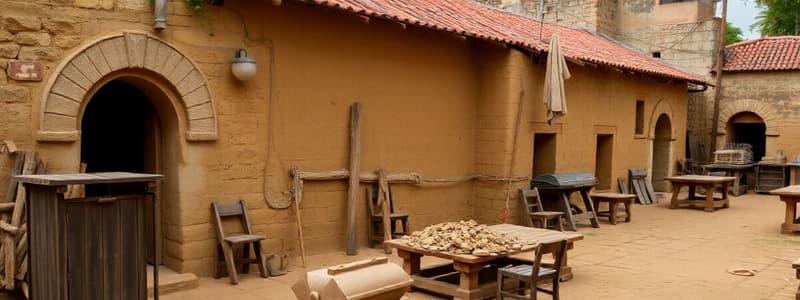Podcast
Questions and Answers
What key aspect differentiates modern definitions of history from traditional definitions?
What key aspect differentiates modern definitions of history from traditional definitions?
- Excludes events and developments
- Includes oral history and cultural artifacts (correct)
- Focus solely on written accounts
- Emphasizes dates and timelines
What is unrecorded history primarily characterized by?
What is unrecorded history primarily characterized by?
- The absence of written records (correct)
- Detailed written accounts of human activity
- Oral traditions passed through generations
- Artistic representations of the past
Which of the following is NOT a task that historians are expected to perform according to the modern definition of history?
Which of the following is NOT a task that historians are expected to perform according to the modern definition of history?
- Analyze various sources
- Interpret and recreate facts
- Discover patterns and trends
- Strictly memorize dates and events (correct)
What does the term 'kasaysayan' emphasize in the context of history?
What does the term 'kasaysayan' emphasize in the context of history?
Which period is classified under recorded history?
Which period is classified under recorded history?
What is the primary purpose of studying history according to the provided content?
What is the primary purpose of studying history according to the provided content?
Which of the following is considered a primary source of history?
Which of the following is considered a primary source of history?
Which of the following methods is used for relative dating of artifacts?
Which of the following methods is used for relative dating of artifacts?
What characterizes secondary sources in the study of history?
What characterizes secondary sources in the study of history?
Which of the following is an example of unwritten primary sources?
Which of the following is an example of unwritten primary sources?
What type of dating method involves using known ages of artifacts for comparison?
What type of dating method involves using known ages of artifacts for comparison?
Which of the following best describes a characteristic of primary sources?
Which of the following best describes a characteristic of primary sources?
Why is understanding history important for developing tolerance towards others?
Why is understanding history important for developing tolerance towards others?
Which auxiliary tool is primarily concerned with the study of ancient handwriting?
Which auxiliary tool is primarily concerned with the study of ancient handwriting?
What aspect is NOT considered when evaluating the competence of an eyewitness?
What aspect is NOT considered when evaluating the competence of an eyewitness?
In the study of history, what is often a challenge due to the lack of availability of materials?
In the study of history, what is often a challenge due to the lack of availability of materials?
Which tool is used for the study of seals and their historical significance?
Which tool is used for the study of seals and their historical significance?
What factor is crucial in assessing the trustworthiness of an observer's account?
What factor is crucial in assessing the trustworthiness of an observer's account?
Which of the following tools deals specifically with family relationships and lineage?
Which of the following tools deals specifically with family relationships and lineage?
Which of these is a primary difficulty faced due to historical writings by foreign writers?
Which of these is a primary difficulty faced due to historical writings by foreign writers?
What does archaeology include in its auxiliary tools?
What does archaeology include in its auxiliary tools?
What is the primary use of dendrochronology in dating wooden objects?
What is the primary use of dendrochronology in dating wooden objects?
Which dating method is used for materials that are up to 60,000 years old?
Which dating method is used for materials that are up to 60,000 years old?
What type of history focuses on political dynamics and governmental structures?
What type of history focuses on political dynamics and governmental structures?
Which component is essential for forming historical records?
Which component is essential for forming historical records?
What is the focus of internal criticism in historical methodology?
What is the focus of internal criticism in historical methodology?
What is the goal of external criticism in historical methodology?
What is the goal of external criticism in historical methodology?
Which of the following is NOT a level of history as described?
Which of the following is NOT a level of history as described?
How does oral history serve a society?
How does oral history serve a society?
Flashcards are hidden until you start studying
Study Notes
What is history?
- History originates from the Greek word "historia," meaning "inquiry" designed to uncover the truth.
- Traditional understandings of history focus on written records of the past.
- Modern definitions incorporate a wider range of sources, including oral accounts, cultural artifacts, and folk traditions.
- History involves collecting, analyzing, and synthesizing information to reconstruct the past by studying events and developments.
- The Filipino word "Kasaysayan" combines "saysay" (meaning, significance) and "salaysay" (narrative), emphasizing the meaning and story behind the past.
Why study history?
- It bridges the gap between the present and the past, explaining causes and conditions of events.
- It helps us understand different perspectives and fosters tolerance.
- It contributes to self-understanding and the development of national identity.
- It promotes nationalism and patriotism.
Types of sources
- Primary sources were created during the event or period being studied, directly involving the event or witnesses of the event. These can include written accounts, graphic materials, artifacts, and oral traditions.
- Secondary sources are interpretations of primary sources, often found in textbooks, encyclopedias, and journal articles.
Examples of sources
- Written primary sources: Chronicles, diaries, memoirs, reports, letters, diplomatic dispatches, surveyor's notes, legal and official documents, statistical tables, graphs, charts, inscriptions, and literary works.
- Unwritten primary sources: Archeological evidence (tools, weapons, structures, artifacts, skeletal remains), creative expressions, arts and crafts, old sketches/drawings/graffiti, photographs, and oral evidence (tales, folk songs, epics, myths, legends).
Dating Methods
- Cultural Dating: Relies on written records of known age associated with artifacts to infer their age. (Absolute Dating: relies on the estimated age of artifact. Relative Dating: compares artifacts to other objects of known age.)
- Scientific Dating:
- Dendrochronology: Matching wood patterns to a master tree ring pattern to determine age.
- Radiocarbon Dating: Measuring the remaining radiocarbon in organic materials (plants and animals) to determine age.
- Potassium Argon Dating: Comparing the amounts of potassium and argon in volcanic rock (with embedded bones and tools) to determine age.
Oral History
- Oral traditions passed down through generations, often in the form of stories, songs, folktales, epics, myths, and legends.
- Despite not being written, oral history provides valuable insights into the past.
Levels of History
- Scope: Biography (individual life), genealogy (family history), local history, national history.
- Focus: Political history, cultural history, special history (focuses on specific aspects or themes), metahistory (theory and methodology of historical study).
Components of History
- Sources: The raw materials historians work with.
- Historian: The individual who interprets and analyzes sources to create historical narratives.
Historical Methodology
- Choosing a topic
- Gathering of sources
- Examination of sources (Historical Criticism)
- External Criticism: Authenticity check; verifying the origin and physical characteristics of a source to rule out forgeries or anachronisms.
- Internal Criticism: Reliability check; assessing the credibility of a source, considering factors like the author's intentions, biases, authority, and limitations.
- Auxiliary Tools: Paleography, diplomatics, archaeology, statistics, and other specialized methods to interpret sources.
- Extraction of data from authentic and credible sources.
- Writing of history: Organization, coherence, and clear writing are expected.
Difficulties in the study of history
- Scarcity of written materials, particularly at the local level.
- Translation and paleographic challenges for documents written in foreign languages (like Spanish).
- Biases and prejudices of foreign writers.
- Lack of comprehensive and representative materials about the whole country.
- Lack of trained historians.
Is History an Art or a Science?
- This is a long-standing debate, with no definitive answer.
- History involves elements of both:
- Scientific methodology: The rigorous analysis of sources, evidence, and facts.
- Artistic interpretation: The creative synthesis of information, insightful analysis, and storytelling.
Studying That Suits You
Use AI to generate personalized quizzes and flashcards to suit your learning preferences.




